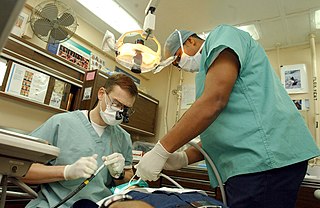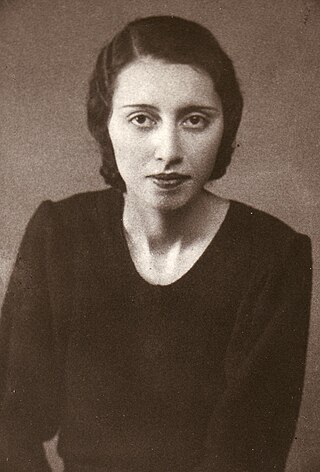
Dentistry, also known as dental medicine and oral medicine, is the branch of medicine focused on the teeth, gums, and mouth. It consists of the study, diagnosis, prevention, management, and treatment of diseases, disorders, and conditions of the mouth, most commonly focused on dentition as well as the oral mucosa. Dentistry may also encompass other aspects of the craniofacial complex including the temporomandibular joint. The practitioner is called a dentist.

A dentist, also known as a dental surgeon, is a health care professional who specializes in dentistry, the branch of medicine focused on the teeth, gums, and mouth. The dentist's supporting team aids in providing oral health services. The dental team includes dental assistants, dental hygienists, dental technicians, and sometimes dental therapists.

The Royal Society of Medicine (RSM) is a medical society based at 1 Wimpole Street, London, UK. It is a registered charity, with admission through membership.
The General Dental Council (GDC) is an organisation which regulates dental professionals in the United Kingdom. It keeps an up-to-date register of all qualified dentists and other dental care professionals such as: dental hygienists, dental therapists, dental nurses, dental technicians and clinical dental technicians. It was established in 1956 to set and maintain standards in UK dentistry, with the aims of protecting the general public from unqualified dental professionals.
The Dental Professionals Association, previously known as the Dental Practitioners Association and the General Dental Practitioners Association, is a trade union for professionals involved in primary dental care in the United Kingdom. It is based in Harley Street in London.

The Swedish Dental Association is the main odontological organization in Sweden. It deals with issues affecting the role of dentists, professional ethics, education and science.
The Melbourne Dental School is one of the graduate schools of the University of Melbourne. In addition to the 4-year graduate dental program the Doctor of Dental Surgery, the school offers specialty training programs combined with the Doctor of Clinical Dentistry degree, advanced training programs, and research degrees including M.Sc. and Ph.D. programs. According to the QS World Rankings, it is the highest ranking dental school in Australia and often ranks among the top 25 in the world.

There is a long history of women in dentistry. Women are depicted as assistant dentists in the middle ages. Prior to the 19th century, dentistry was largely not yet a clearly defined and regulated profession with formal educational requirements. Individual female dentists are known from the 18th century. When the profession was regulated in the 19th century, it took a while before women achieved the formal education and permission to engage in dentistry.

Lilian Lindsay, CBE, FSA was a dentist, dental historian, librarian and author who became the first qualified female dentist in Britain and the first female president of the British Dental Association.
Sir Nairn Hutchison Fulton Wilson is the Honorary Professor of Dentistry, former Professor of Restorative Dentistry and Dean and Head of King's College London Dental Institute from 2001 until 2012 and Deputy Vice Principal (health) between 2009 and 2012.
George Northcroft was a British orthodontist who is known for his contributions in the formation of the British Orthodontic Society. The society was initially formed in 1907 as British Society for the Study of Orthodontics (BSSO) and the name later changed to British Orthodontic Society. He also played an important role in formation of the Dental Act of 1921 which made dentistry a profession in Great Britain.
Charles Edward Wallis, otherwise known as the 'father' of the London School Dental Service, was a physician and dental surgeon in London in the early 20th century. As one of the first assistant medical officers to London County Council, his research led to the establishment of a school dental treatment service and an improvement in child welfare.
The Lindsay Society is a British dental history open to anyone interested in the subject, including non-dentists. It has close links with the British Dental Association dedicated to the study of the history of dentistry.

Stanley Gelbier is emeritus professor of dental public health and honorary professor of the history of dentistry at King's College London. He is a past president of the History of Medicine Society, and the former curator of the British Dental Association's museum.

James Neil Swallow was a pioneering British dentist who developed treatments for adults and children with mental and physical disabilities. He co-authored a standard textbook on children's dentistry. In 1964, Swallow became senior lecturer in children's dentistry at the Cardiff Dental School. This was followed in 1975 by his appointment as professor of paediatric dentistry at the University of Amsterdam, and then as professor of restorative dentistry at Belfast Dental School in 1978.

John Saville Zamet FDS was a periodontist in the United Kingdom. He established the first exclusively periodontal practice in London in 1966.
Sir Francis Mark Farmer was a dental surgeon and lecturer on dental surgery and pathology at the London Hospital. He made contributions on facial restoration after gunshot wounds.
Frederick Newland-Pedley was a British physician and dentist known for his contribution to the fields of military dentistry and dental education.

The Royal Dental Hospital was a dental hospital in Leicester Square, London, which operated from 1858 until 1985. In 1859, it opened the London School of Dental Surgery, later renamed to the Royal Dental Hospital of London School of Dental Surgery, which was the first dental school in Britain.
The Odontological Society of Great Britain was a learned society formed in 1863 by the merger of the Odontological Society of London and the College of Dentists of England, both of which had been founded within a day of each other in 1856. In 1907 it joined the Royal Medical and Chirurgical Society and other specialist medical societies to form the Royal Society of Medicine.










